Tickles Saves Pickles - With The Help Of Social Media
Maddie
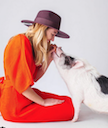 When this little pig got sick and needed a blood transfusion, his guardian, Maddie worked effortlessly to find a match. Thanks to social media, Pickles the Potbellied Pig was saved by Tickles, a 450 lb. donor pig, whom was also saved from the butcher in this 'win-win-win' hog story.
When this little pig got sick and needed a blood transfusion, his guardian, Maddie worked effortlessly to find a match. Thanks to social media, Pickles the Potbellied Pig was saved by Tickles, a 450 lb. donor pig, whom was also saved from the butcher in this 'win-win-win' hog story.
When Pickles was just a couple of months old, Maddie took him traveling with her, staying at an Airbnb. Unbeknownst to Maddie, Pickles got into rat poisoning that perhaps was under a fridge or in a closet. She tells us if you know anything about pigs, you know they will get into anything and everything possible.
It took a few days for the poison to get into his system and then he became really sick. Pickles was vomiting and lost his entire coloring. He was also having a lot of trouble breathing. However, Maddie didn't know what was causing his sickness.
Vets x rayed Pickles' lungs and they found that he had fluid in them. Initially they thought maybe he had pneumonia, but when they went to tap his lungs, huge amounts of blood came pouring out. There was so much blood loss that they actually had to do something they had never done before called an auto-transfusion, which was to put Pickle's own poisoned blood back into him. They actually had to take syringes and get the blood off the floor and the table where it had spilled over. They had to inject that blood back into him, because he only had 4-percent of his red blood cell count left.
Why would any doctor put poisoned blood back into a patient? Normally donor blood is used for transfusions. However, Maddie had taken Pickles to UC Davis, and despite being one of the largest blood banks on site for cats and dogs and even horses, they didn't have any pig blood. She also stated it's actually really rare for a pet hospital to have pig blood on hand.
Maddie then got a call from UC Davis saying they were doing everything possible, but Pickles only had about six hours left to live. Maddie says she just blurted out, without much thought, if she somehow found a donor pig and rushed the pig to UC Davis, could they perform a blood transfusion? The answer was yes.
 That left Maddie answering the question of where the heck was she going to find a donor pig within six hours, get permission to borrow it for a blood transfusion and then get it transported over to UC Davis?
That left Maddie answering the question of where the heck was she going to find a donor pig within six hours, get permission to borrow it for a blood transfusion and then get it transported over to UC Davis?
Her first thought was to get a pig from the woman that she rescued Pickles from. The farm was nearby and the woman was fortunately sympathetic to the situation. This woman immediately threw one of her pigs in the back seat of Maddie's car and she rushed it over to UC Davis within an hour. UC Davis checked the pig to make sure she was healthy. However, it turned out that no one knew the pig was pregnant, so she couldn't be a blood donor.
Maddie was happy for the family's exciting news, but it really stunk for her. It was now back to the drawing board.
Next, Maddie went on Craigslist and found a 450-pound butcher pig that was being sold. Pickles needed so much blood, Maddie thought the bigger the better, and found the biggest pig possible. Maddie called the owner and asked them if she could borrow their pig. She says that this was probably the weirdest phone call she had ever placed. Turns out the owner was also very sympathetic and a very sweet guy. However, he told her he could make the pig available, but he didn't have the transportation to get her to UC Davis.
At that time, Maddie was really running against the clock. So she went back on Craigslist and found another guy who said he transported trailers and was a hauler, so she called him. Again, another super incredibly nice man who offered to help.
The man told Maddie that he didn't have a trailer, but he was available. Maddie then asked him if he could go rent a U-Haul and not tell them what he was doing or how he was going to use it. Next, she asked him to go and pick up this 450-pound pig and bring it to UC Davis. This man had no experience with pigs, but was the sweetest guy and willing to help. He was with his family and even had his kids and wife in the car. He agreed to do it right away.
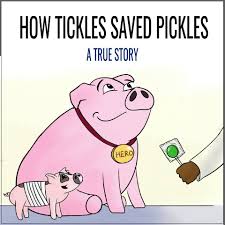 Long story short, the pig made it to UC Davis in time and Pickles received the transfusion, which saved his life.
Long story short, the pig made it to UC Davis in time and Pickles received the transfusion, which saved his life.
After the transfusion, Maddie was completely indebted to the donor pig and could not obviously let her be sold to the butcher. It turns out all of Pickles' Instagram followers helped her find a home for the pig, now named Tickles, who will live the rest of her life on a farm. Both Maddie and Pickles even visit Tickles on occasion.
You can follow Pickles on Instagram, which originally started as a way to keep friends and family apprised of what was happening. But other people got very invested in Pickles' story, so Maddie keeps it updated.
Visit Instagram
PVP's - Your Pet's Best Friend!
Dr. Natalie Marks, Blum Animal Hospital
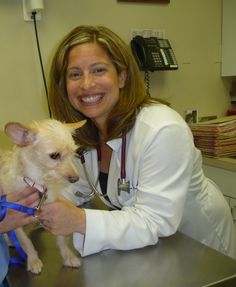 Veterinarian Dr. Natalie Marks sits on the Fear Free National Advisory Board. She's also a national educator helping other private practitioners develop Fear Free techniques. Dr. Marks suggests that pet owners use Pre-Visit Pharmaceuticals (PVP) before you go to the veterinarian. This will make the visit easier and more pleasurable for your pet. She says these medications are not sedatives or painkillers, but are effective for easing anxiety.
Veterinarian Dr. Natalie Marks sits on the Fear Free National Advisory Board. She's also a national educator helping other private practitioners develop Fear Free techniques. Dr. Marks suggests that pet owners use Pre-Visit Pharmaceuticals (PVP) before you go to the veterinarian. This will make the visit easier and more pleasurable for your pet. She says these medications are not sedatives or painkillers, but are effective for easing anxiety.
Dr. Marks explains that a PVP is also known as a pre-visit pharmaceutical. It's for clients that have dogs and cats that exhibit fear, anxiety or what is called defensive reactivity. This is a pet that gets nervous when someone starts to approach it, or starts to restrain it, when they're at the veterinary office. They may start to react adversely by growling, biting and lunging. Luckily there are now strategies and medications that can be given at home by the pet owner to help reduce anxiety and fear and stress well before the vet visit.
So what's the difference between a PVP, sedation or even a painkiller? PVP's are more of an anti-anxiety medication. Medications like Trazodone or Gabapentin, traditionally lower the anxiety of the pet. Dr. Marks explains that there's a slight bit of crossover in that some PVP's can have some pain reducing qualities, but these are not meant to create tremendous sedation for those patients. Dr. Marks doesn't want her patients coming in struggling to walk or needing to be monitored. So they're not giving a sedative, per se, they're giving what they call an anxiolytic or a medication that removes or reduces anxiety.
While they do use things like Xanax on some of patients, explains Dr. Marks, there are a lot of different options depending on the patient's breed, age and underlying medical condition as well as what's worked before.
In order for some pets to have a Fear Free vet visit, PVP's are very important. Dr. Marks calls this the fear cascade. Take for example a cat that only leaves the house once a year to come to the veterinary office. Once that cat sees a carrier, they're going to get anxious or nervous if no one has worked with them at home to reduce the fear of the carrier. Then the car travel, which is only once a year, is potentially going to cause fear and anxiety as well. So by the time they get to the veterinary office, they're already sort of in this workup mode or this cascade of anxiety. Then by the time Dr. Marks sees that patient, she is far surpassed what she would consider a comfortable place for them to be. Not just for the cat or dog, but also for the pet owner too.
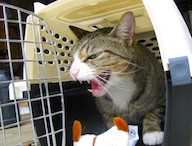 So Fear Free involves reducing fear, anxiety and stress in not just their patients, but also everyone who cares for them. This includes the client as well as the veterinarian and the veterinarian staff. Dr. Marks wants to make sure that everyone that's involved in the care of your pet can reduce fear, anxiety and stress because it really provides them the best chance to give the best medicine.
So Fear Free involves reducing fear, anxiety and stress in not just their patients, but also everyone who cares for them. This includes the client as well as the veterinarian and the veterinarian staff. Dr. Marks wants to make sure that everyone that's involved in the care of your pet can reduce fear, anxiety and stress because it really provides them the best chance to give the best medicine.
You might think that any medication given prior to a vet visit might affect any diagnostic tests that the veterinarian does. However, Dr. Marks tells us that it actually improves some of the diagnostic accuracy. It allows her to do a much more thorough physical exam. She says she has heard frequently from feline owners who come to her for a Fear Free exam and tell her that this is first time anyone has been able to look in their cat's mouth in a decade. Dr. Marks hears that all the time, because she's not only allowing them to relax and trust in the whole Fear Free experience, she is making it so that she can really do a thorough physical exam.
Dr. Marks tells us one particular dog where a PVP made a really big difference. Cali had been a patient of Dr. Marks for over a decade and is probably the epitome of the most anxious Wheaten Terrier that has ever existed. Her dad, of course, is madly in love with her, but very anxious, nervous and upset himself. It was always sort of a myriad of emotions when Cali would come to her practice, because before Fear Free, they didn't have a great strategy to help her tolerate and understand and learn new behaviors that would allow her to be less anxious. So in the past, and Dr. Marks believes this to be true for many veterinarians who are practicing this way, they've used e-collars, muzzles and other restraint tools when the patient was still anxious, which unfortunately just added to their fearful response.
Now with Cali, they have created a cocktail of PVP's that dad gives to her two hours before she comes to the office. They've also created different strategies for her travel within the car, which includes her wearing a ThunderShirt along with pheromones supplementation as well. This has allowed Cali to finally come in after some happy visits and actually accept treats, do her obedience commands and be able to be physically examined in a comfortable way.
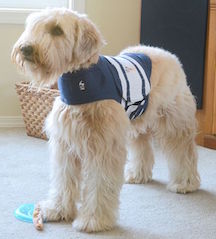 Dr. Marks states that this has taken many weeks and many visits for the owner and herself. However, it's incredibly rewarding for her to be able to actually now see inside Cali's mouth, where she recently just found some dental disease that she's addressing, for dad to be more relaxed and actually enjoy the experience of coming to the veterinary office and feeling sort of proud of his success, and obviously for Cali the most important part of this triangle, who feels a lot more comfortable because she doesn't have this kind of wind down miserable day after being there and they're not adding to that fear cascade. They're sort of changing her outlook on coming and allowing her to settle and learn new techniques that make her reduce fear, anxiety and stress. And that's the whole goal of Fear Free.
Dr. Marks states that this has taken many weeks and many visits for the owner and herself. However, it's incredibly rewarding for her to be able to actually now see inside Cali's mouth, where she recently just found some dental disease that she's addressing, for dad to be more relaxed and actually enjoy the experience of coming to the veterinary office and feeling sort of proud of his success, and obviously for Cali the most important part of this triangle, who feels a lot more comfortable because she doesn't have this kind of wind down miserable day after being there and they're not adding to that fear cascade. They're sort of changing her outlook on coming and allowing her to settle and learn new techniques that make her reduce fear, anxiety and stress. And that's the whole goal of Fear Free.
Dr. Natalie Marks obtained her bachelor's degree with High Honors in Animal Science from the University of Illinois in 1998, and then proceeded to obtain a Masters in Veterinary Medicine and Doctorate of Veterinary Medicine degree with High Honors from the University of Illinois College of Veterinary Medicine. She has been a veterinarian at Blum Animal Hospital since 2006 and Medical Director since 2012.
You can find these great tips from Dr. Natalie Marks, as well as others to enrich your pet's life and make their vet visits Fear Free at Fear Free Pets and Fear Free Happy Homes.
Listen and Explore the Fear Free Expert Series
Couple Rescues "Handicats"
Joe and Lauren DiPaolo
 Joe and Lauren DiPaolo have devoted everything to rescuing handicapped cats, or 'handi-cats.' Their house is full of cats with one or multiple ailments. They're providing life-long care for a feline without eyes, a kitty using a wheel contraption in place of legs and one with a cleft palate, just to name a few of the maladies. You must hear them tell you their story of undying devotion.
Joe and Lauren DiPaolo have devoted everything to rescuing handicapped cats, or 'handi-cats.' Their house is full of cats with one or multiple ailments. They're providing life-long care for a feline without eyes, a kitty using a wheel contraption in place of legs and one with a cleft palate, just to name a few of the maladies. You must hear them tell you their story of undying devotion.
Lauren says it all started with before she met her husband Joe. She found her first "handicat" when she was 15 years old. Someone had cut one of the legs off this cat and left her in a box. She cried to her parents to let her keep her, and they did. She had this cat for 16 years.
After that cat passed away, she actually found another cat outside and he was passed out. Lauren didn't know anything was wrong with him. However, when she took him to the vet, they diagnosed him with cerebellar hypoplasia and they wanted to put him down. Lauren wasn't familiar with the condition and neither was the vet. So she went home, did a lot of research and even joined a support group. But it turned out it is basically a condition that affects his motor skills. He can't stand or walk, but Lauren says he's awesome and has just turned six years old. She tells us that's really where rescuing of these special needs cat stems from.
When she started dating her husband Joe, she says he didn't like cats. He tells is that he loves animals, but just wasn't a fan of cats.
At that time, Lauren only had the one cat with cerebellar hypoplasia, named "Little." Joe kept asking her to come over for dinner, but she told him that she couldn't leave her cat alone. Finally Joe gave in and said she could bring the cat with her.
Lauren showed up at his door, and since Little cat couldn't walk, he requires a lot of equipment. Lauren had to bring a cat bowl and food, Little's tent, a mat, blanket and a litter box. She says Joe didn't have any idea what he was in for, but it worked.
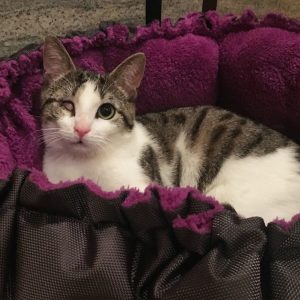 Again, Joe tells us he wasn't used to cats in general, but handicapped cats were a whole other game. Little initially made Joe nervous, as he would wobble a lot and Joe didn't know how to handle him.
Again, Joe tells us he wasn't used to cats in general, but handicapped cats were a whole other game. Little initially made Joe nervous, as he would wobble a lot and Joe didn't know how to handle him.
According to Lauren, it took about two weeks for Joe to bond and start petting Little and to become a cat person.
After Lauren and Joe started dating and he fell in love with Little, he was the one that rescued the rest of the handicats. Their next handicat was Mika, and Joe found her in the middle of the street. He thought she was a raccoon and he went to shoo her away, but he saw it was a cat with no eyes. It turns out this was an eye condition she was born with that left her blind. So Joe took her in.
Next, Joe ended up adopting Mac, who was in the shelter for 10 months and was overlooked. Nobody wanted him because he has a cleft palate. So people thought he looked ugly. Meanwhile, Lauren says he's the cutest cat she's ever seen! Mac has a flat profile from the side, half a nostril and looks like Lord Voldemort. He also has cardiomyopathy. Because of this, he snorts and sounds like a gremlin.
Their newest member is Leela, who has one eye, another one of Joe's acquisitions according to Lauren.
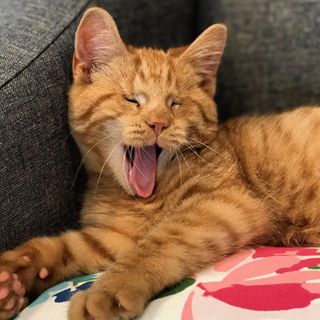 Taking care of so many handicats takes time and Joe and Lauren seem to have it all worked out. They both work, with Joe actually working two jobs. They have it worked out so that Joe works from 6:00am-2:00pm. Lauren works from 2:00pm-10:00pm, so she is home with the cats in the mornings. When Joe gets home at 2:00pm, he feeds them and spends about an hour with them before returning to work at his second job for a short time, before coming home again before Lauren returns. When Lauren gets home, Joe goes to sleep and she stays up with the cats.
Taking care of so many handicats takes time and Joe and Lauren seem to have it all worked out. They both work, with Joe actually working two jobs. They have it worked out so that Joe works from 6:00am-2:00pm. Lauren works from 2:00pm-10:00pm, so she is home with the cats in the mornings. When Joe gets home at 2:00pm, he feeds them and spends about an hour with them before returning to work at his second job for a short time, before coming home again before Lauren returns. When Lauren gets home, Joe goes to sleep and she stays up with the cats.
This schedule seems to work for them. Lauren is also able to bring the cats to work with her. So she rotates them and brings a different one each time. She owns a dance studio and the children love it when she brings the cats in.
Lauren enjoys this as well, because she is letting kids know that there is nothing wrong with being different. There is so much bullying going on in the world today and tries to relate the cats' conditions with the children. For example, she has one kid who's upset because she has acne. But her attitude changes when she sees a cat that only has two legs. Lauren tries to reiterate that it's okay to be different or look different.
It is also pretty costly to take care of so many handicats. Joe and Lauren have set up an Instagram account. They currently have 114,000 followers. Lauren says if it wasn't for these people sending them food, litter and money for emergency surgeries, they would never be able to have six handicats. She tells us that recently one of their cats had to have a costly surgery to have his eye shown shut because of recurrent eye infections. The future is also uncertain for another young cat that only has two legs, as surgery may be necessary. And then there's Mac, with the cleft palate, who had to have three emergency surgeries in a short amount of time. The vet was trying to open a second nostril and he went into heart failure. Mac flat-lined and the vet said he wouldn't live through the night. Mac is now going to be three years old and requires the most attention. They use nebulizers daily and he sleeps with a humidifier next to his bed.
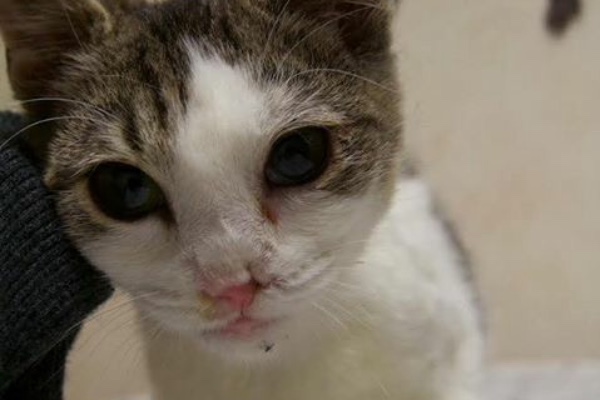 These cats are all alive because of everyone jumping in and helping. Joe and Lauren are very thankful for the support and backup from everyone and say that these people are the real reason these cats are being saved, because they couldn't do it alone.
These cats are all alive because of everyone jumping in and helping. Joe and Lauren are very thankful for the support and backup from everyone and say that these people are the real reason these cats are being saved, because they couldn't do it alone.
Most people who have handicapped pets at home usually work in the animal field or are rescuers. However, Lauren says she has always loved cats. When she was about six years old, their family dog passed away and there was a cat outside. Her parents were going to the North Shore Animal League to adopt another dog, when Lauren begged them to get another cat. Unfortunately she was outnumbered because her mom, dad and brother were set on getting a dog. Lauren still begged her mother to at least look at the cats while she was there. So her mother went and looked at the cats, and she won, because they came home with a cat, which was only the beginning.
Visit Instagram
The Dangers of Doggie Dragon Breath - Dr. Debbie
 Does your dog's breath cause you to gag and turn away? Are your pet's kisses unwelcome due to fetid breath? Many dog owners recognize that distinctive smell which is often accepted as a condition of dog ownership. But stinky dog breath, while common, is actually a symptom of illness and should not be ignored. Doggie dragon breath, just like a blinking traffic light, is a sign of danger ahead. Don't ignore dog breath for what it is - an indicator of oral infection that if left unchecked will impact your dog's health and shorten his lifespan.
Does your dog's breath cause you to gag and turn away? Are your pet's kisses unwelcome due to fetid breath? Many dog owners recognize that distinctive smell which is often accepted as a condition of dog ownership. But stinky dog breath, while common, is actually a symptom of illness and should not be ignored. Doggie dragon breath, just like a blinking traffic light, is a sign of danger ahead. Don't ignore dog breath for what it is - an indicator of oral infection that if left unchecked will impact your dog's health and shorten his lifespan.
What's the big deal about bad breath? It's more than just the smell. Bad breath, also referred to as halitosis, arises from plaque and oral bacteria. Periodontal disease progresses as plaque accumulates, mineralizes into tartar, and inflammation causes destruction of the supportive tissues around the teeth. Dogs don't simply get cavities, rather they will lose their teeth as connective attachments deteriorate. Untreated dental infections jeopardize the health of nearby teeth and may lead to osteomyelitis - infection in the bone. And with time, untreated periodontal disease showers the bloodstream with bacterial products leading to other diseases such as liver, kidney and heart disease.
Fight Halitosis
The best way to control periodontal disease is to assume an offensive attack. Monitor your pet's oral health by flipping up your dog's lip to discover what is lurking underneath. Look for red inflamed gums, yellow or brown accumulation on the teeth, tooth discoloration, or bad breath. Any symptoms of periodontal disease should be addressed with your veterinarian. Have your pet's teeth cleaned regularly at the veterinary office and follow up with home dental care including daily brushing.
These professional veterinary cleanings are important to safely remove mineralized tartar, clean under the gum line, permit a thorough oral exam and take x-rays. Veterinary dental x-rays are an essential tool in detecting problems and have been shown to identify oral disease in 28-percent of dogs and 42-percent of cats that have an outwardly normal mouth.
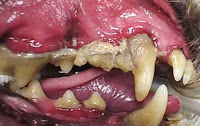 Don't fall into the hype about herbal spray-on products or 'awake' dental procedures - these only offer a cosmetic improvement in visible tartar, which only covers a small part of the tooth. These methods, often incorrectly touted as a safe alternative to professional cleanings, can't address the 60-percent of a dog's tooth which lies under the gum line - exactly where periodontal disease brews and does its damage.
Don't fall into the hype about herbal spray-on products or 'awake' dental procedures - these only offer a cosmetic improvement in visible tartar, which only covers a small part of the tooth. These methods, often incorrectly touted as a safe alternative to professional cleanings, can't address the 60-percent of a dog's tooth which lies under the gum line - exactly where periodontal disease brews and does its damage.
Once you identify that nasty doggie breath, you can be certain some degree of periodontal disease is present and dental intervention is needed. Statistics show that by 3 years of age 80-percent of dogs and cats already have periodontal disease. Don't forget that small and toy breeds of dog have accelerated dental problems diagnosed as young as 1 to 2 years of age.
Think prevention - have your dog's teeth cleaned and embrace home dental care steps. And the next time you find yourself in a cloud of canine halitosis, you won't turn the other way - you'll grab that toothbrush.
Featured veterinarian known as "Dr. Debbie" on national pet radio program, Animal Radio. Ebook author of "Yorkshire Terriers: How to Be Your Dog's Best Friend"; "Pugs: How to Be Your Dog's Best Friend"; "Mini Schnauzers: How to Be Your Dog's Best Friend"; and "Shih Tzu: How to Be Your Dog's Best Friend." Dr. Debbie's books.
Visit Website
Animal Radio News - Lori Brooks
 Raw Pet Food & Treats Put People & Pets at Risk
Raw Pet Food & Treats Put People & Pets at Risk
A new study has found raw pet food and treats often contain food poisoning bugs such as E coli, salmonella and listeria. Pet parents are also at risk for diarrhea and vomiting just by handling the raw food, your pet's food bowls or even letting your cat or dog lick your hand after they've eaten raw food. Most human infections have been linked to dried pig ears and contaminated chicken jerky pet treats. The study, published in the British Journal the Veterinary Record, looked at brands of raw pet food sold in the Netherlands. However, the same warnings are being made in the UK, where owners are buying high-end raw pet food or creating their own from the butcher. This study conducted by Dutch researchers analyzed 35 products containing mostly chicken, beef and lamb. They found the food poisoning bug E coli in 28 of them, listeria in 19 and salmonella in 7 of the raw foods and treats. This is a big warning to pet parents.
 Chris Brown's Pet Monkey Confiscated
Chris Brown's Pet Monkey Confiscated
California Fish and Wildlife agents have seized singer Chris Brown's pet monkey from the pop star's Los Angeles home. Investigators say Brown did not have a permit for the capuchin monkey named Fiji. Just last month, Brown posted an Instagram video of his 3-year-old daughter cuddling with the monkey, so it's not something he was trying to hide from authorities.
Microchips Fail
About 15,000 family pets need to have a new microchip inserted because their old microchip no longer works. Especially sad news since it could lead to some pets being mistaken for strays and put down. Pets that are micro-chipped with a product called BioTec, manufactured by Virbac, are at risk. There has reportedly been a problem with the brand and model in the past. In 2012, some pets needed new chips implanted, because their original BioTec chips couldn't be detected when scanned. The affected owners had the chips replaced and vets stopped implanting them. That was the end of the story until now. A letter from Virbac says, "It now seems possible all of those BioTec chips might fail over time." Up to 15,000 pets could be affected. The BioTec microchips of concern were inserted between 2009 and 2012. No other Virbac products have been affected. The affected chips have 15-digit numbers beginning with 900088, 9000088, or 9000010. Of course, microchips save so many pets, but the SPCA also suggests putting an identification tag on their collar.
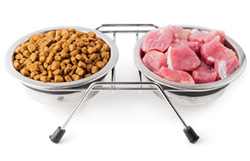 If You Feed Your Pet a Raw Diet - Don't Let Them Lick You!
If You Feed Your Pet a Raw Diet - Don't Let Them Lick You!
There are so many pet parents who feed raw food or treats as well as those that are freeze dried or dehydrated. And, of course, the rising popularity of trendy raw meat diets for pets is also putting owners at risk of serious bacterial diseases such as E-coli, listeria and salmonella. What you may not have known before is that scientists say dogs and cats fed raw meat-based diets can pass these bacteria to their humans by licking them, which means it can also be passed on when you kiss your dog or cat. This study was published in the journal Vet Record, a British Medical Journal. The study looked at 35 raw meat pet food products, which also included treats. These 35 products came from eight different brands and found: 86-percent of the 35 products tested had the bacteria that cause E-coli, while Salmonella was detected on 20-percent of the raw foods and treats. The very serious and often deadly listeria bacterium was found in nearly half of the products tested. Listeria can cause very serious complications and even death, but is especially dangerous in pregnant women, the elderly or in people with weak immune systems. Last year a program which sends dogs into schools to help children read banned the use of animals fed raw meats because of the health risk to children. Keep in mind that the study confirms that E-coli, salmonella and listeria can be transferred "through direct contact with the food; through contact with a contaminated pet, such as sharing the same bed and allowing licking of the face and hands; through contact with household surfaces; or by ingesting cross-contaminated human food." The researchers also found evidence the raw meat products were carrying antibiotic-resistant bacteria, threatening to build up immunity to drugs in animals and their humans. Raw meat based diets include raw dried dog and cat treats such as pig ears, home-prepared meats sourced from food sold for human consumption and commercial raw meats marketed for pets.
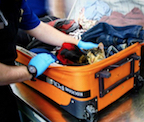 Couple Stows Cat in Luggage
Couple Stows Cat in Luggage
A young Florida couple is facing animal cruelty charges after airport security agents at the Erie, Pennsylvania airport found a cat in their luggage. The 6-month-old female cat named Slim was literally inside the suitcase along with the couples' clothing and other items. The 21-year -old owners were planning to fly from Erie to Tampa, Florida, on New Year's Day with the stored car. Luckily, the Erie TSA team spotted the cat during pre-flight inspections. The couple then traveled home to Florida without poor Slim who is now in custody herself until the case is resolved. The owners were each charged with one count of transporting an animal in a cruel manner.
 Listen to the entire Podcast of this show (#947)
Listen to the entire Podcast of this show (#947)





